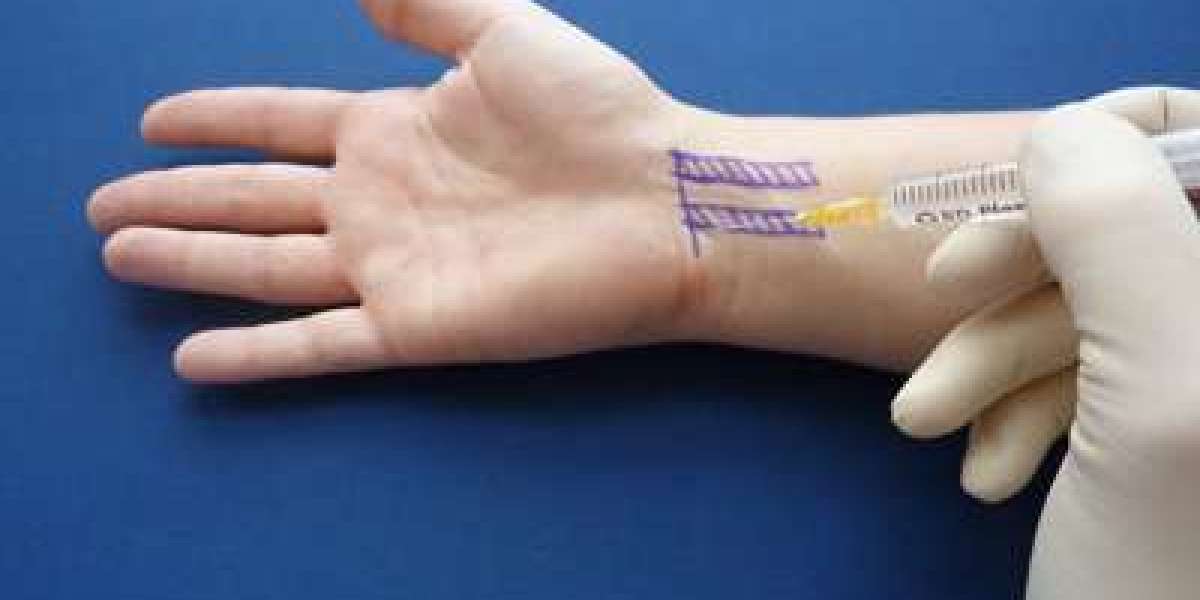Carpal Tunnel Syndrome (CTS) is one of the most common nerve compression conditions, often leading to discomfort, numbness, tingling, and pain in the hands and wrists. For individuals struggling with this condition, various treatments are available, ranging from lifestyle changes and splints to surgical options. Among these, one of the most effective non-surgical methods for managing symptoms is the use of carpal tunnel injections. These injections can offer significant pain relief and improved function, particularly when other conservative treatments have not provided adequate results.
In this comprehensive guide, we will explore everything you need to know about carpal tunnel injections, including how they work, the procedure, benefits, possible side effects, and recovery expectations.
What Is Carpal Tunnel Syndrome?
Carpal Tunnel Syndrome occurs when the median nerve—responsible for controlling sensations and movements in parts of the hand—is compressed as it passes through a narrow passageway in the wrist called the carpal tunnel. This compression often results from repetitive hand movements, wrist injuries, or underlying conditions such as arthritis, diabetes, or hypothyroidism.
The symptoms typically include tingling, numbness, and weakness in the thumb, index, middle, and part of the ring finger. People who work long hours typing, sewing, or performing assembly line tasks often experience these symptoms due to continuous strain on the wrist. When left untreated, the discomfort may worsen over time, eventually affecting the ability to perform even simple daily activities.
What Are Carpal Tunnel Injections?
Carpal tunnel injections are a non-surgical treatment designed to reduce inflammation and pressure around the median nerve. The procedure typically involves injecting a corticosteroid medication, sometimes combined with a local anesthetic, into the carpal tunnel area. This helps relieve pain and swelling, allowing the nerve to function more effectively.
The goal of these injections is not only to reduce immediate discomfort but also to improve hand function and delay or prevent the need for surgery. They are usually recommended for individuals whose symptoms persist despite initial conservative measures such as wrist splints, rest, or physical therapy.
How Do Carpal Tunnel Injections Work?
Corticosteroids are powerful anti-inflammatory agents that help reduce swelling and inflammation around the compressed median nerve. When injected directly into the carpal tunnel, they help relieve the pressure that causes pain and numbness.
The local anesthetic included in the injection provides rapid, short-term relief, while the steroid component works over several days or weeks to provide more sustained improvement. The combination of these medications offers both immediate and long-lasting symptom relief.
It’s important to note that while injections can significantly reduce pain and inflammation, they do not permanently cure Carpal Tunnel Syndrome. The benefits may last anywhere from a few weeks to several months, depending on the severity of the condition and individual response to treatment.
The Procedure: What to Expect During Carpal Tunnel Injections
Receiving a carpal tunnel injection is a relatively quick and straightforward procedure that can often be performed in a doctor’s office or outpatient clinic.
Step 1: Preparation
Before the injection, the healthcare provider will clean the wrist area to prevent infection. Sometimes, an ultrasound device may be used to help guide the needle precisely into the carpal tunnel space, ensuring the medication is delivered to the exact location needed.
Step 2: Administration
A small needle is inserted into the wrist, and the steroid-anesthetic mixture is carefully injected around the median nerve. The process usually takes only a few minutes and causes minimal discomfort.
Step 3: Aftercare
After the injection, the patient may experience mild soreness or swelling at the injection site, which typically subsides within a day or two. Patients are generally advised to rest the wrist for at least 24 hours and avoid heavy lifting or repetitive hand activities immediately after the procedure.
Benefits of Carpal Tunnel Injections
The use of carpal tunnel injections can provide multiple benefits for patients experiencing moderate to severe symptoms:
1. Rapid Pain Relief
Many individuals notice improvement within a few days after receiving the injection. The combination of a local anesthetic and corticosteroid provides both short-term and long-term symptom relief.
2. Reduced Inflammation
The primary purpose of corticosteroids is to reduce inflammation around the median nerve. By doing so, the compression on the nerve decreases, easing discomfort and restoring normal hand function.
3. Non-Surgical Alternative
For patients who are not ready or suitable for surgery, injections offer an effective alternative that can significantly improve quality of life without the downtime associated with surgical recovery.
4. Improved Functionality
Decreased pain and swelling enable individuals to regain strength and dexterity in their hands, making daily activities easier to perform.
5. Diagnostic Value
Injections can also serve a diagnostic purpose. If symptoms improve after the injection, it helps confirm that Carpal Tunnel Syndrome is indeed the cause of the patient’s discomfort.
Who Should Consider Carpal Tunnel Injections?
Carpal tunnel injections are typically recommended for individuals who have not achieved adequate relief from initial conservative treatments such as wrist splints, anti-inflammatory medications, or physical therapy. They are particularly beneficial for:
People with mild to moderate symptoms seeking temporary relief.
Individuals unable to undergo surgery due to health conditions.
Patients awaiting surgical treatment but needing short-term symptom control.
Workers requiring symptom management to continue their daily tasks comfortably.
It’s important to consult a qualified healthcare professional to determine if this treatment is appropriate. A thorough evaluation, including a physical examination and possibly nerve conduction studies, will help guide the decision.
Possible Risks and Side Effects
While carpal tunnel injections are generally safe, as with any medical procedure, there are potential risks and side effects. Common and usually mild side effects include:
Temporary pain or swelling at the injection site.
Slight bruising or tenderness.
Temporary numbness in the hand.
Less commonly, patients may experience:
Infection at the injection site (rare).
Allergic reactions to the medication.
Weakness or thinning of nearby tendons if multiple injections are administered over time.
Temporary increase in blood sugar levels, particularly in diabetic patients.
These risks are relatively uncommon, especially when the procedure is performed by an experienced professional using sterile techniques.
Effectiveness and Longevity of Results
The effectiveness of carpal tunnel injections varies from person to person. Many individuals experience significant pain relief lasting from several weeks to several months. For some, symptoms may return gradually, while others may enjoy extended relief.
In some cases, the injections can help manage the condition long-term when combined with other treatments like ergonomic adjustments, wrist splints, and physical therapy. However, if symptoms persist or worsen despite repeated injections, surgical intervention may be necessary to release the pressure on the median nerve permanently.
Alternative Treatments to Carpal Tunnel Injections
Although injections provide effective symptom relief, they are just one part of a comprehensive treatment approach. Depending on the severity of the condition, alternatives may include:
Wrist Splints: Especially useful at night, splints keep the wrist in a neutral position to reduce pressure on the median nerve.
Physical Therapy: Stretching and strengthening exercises can improve flexibility and reduce strain.
Medications: Over-the-counter anti-inflammatory drugs can help alleviate pain and swelling.
Surgery: In severe or persistent cases, a surgical procedure known as carpal tunnel release may be necessary to permanently relieve nerve compression.
Combining these strategies with lifestyle modifications—such as improving ergonomic setups and taking regular breaks from repetitive tasks—can greatly enhance long-term outcomes.
Recovery and Aftercare
Following a carpal tunnel injection, patients are usually able to resume light activities within a day or two. It’s normal to feel mild soreness in the wrist initially, but this typically resolves quickly. Applying ice packs, resting the hand, and avoiding strenuous wrist movements can help speed up recovery.
Your doctor may recommend follow-up visits to assess progress and determine if additional treatments are needed. If symptoms return, a repeat injection may be considered, but most physicians limit corticosteroid injections to avoid potential tissue damage.
Conclusion
For individuals struggling with the persistent pain and discomfort of Carpal Tunnel Syndrome, carpal tunnel injections offer a safe, effective, and minimally invasive solution. They provide fast relief, reduce inflammation, and help restore functionality to the hands and wrists.
While these injections are not a permanent cure, they can be an essential part of a broader treatment strategy that includes lifestyle adjustments, physical therapy, and, when necessary, surgical intervention. Consulting with a healthcare provider is the best way to determine whether this approach is right for your condition.
By understanding how these injections work and what to expect from the procedure, you can make informed decisions about your health and take meaningful steps toward relief and recovery.








